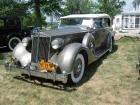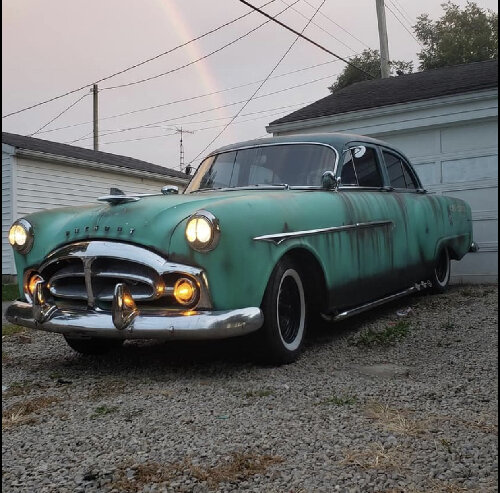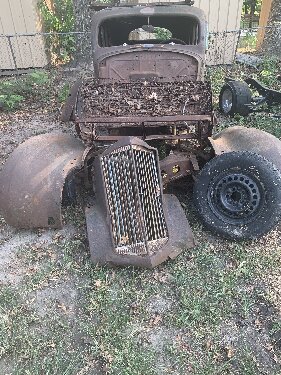|
Re: Brakes
|
||||
|---|---|---|---|---|
|
Webmaster
|
For those interested, there is a old stock Minor Kit on ebay. I would rather user new stock. But it way be good just for comparisons:
http://cgi.ebay.com/ebaymotors/1952-53-54-55-56-PACKARD-NOS-BENDIX-POWER-BRAKE-KIT_W0QQitemZ160179424510QQihZ006QQcategoryZ34199QQssPageNameZWDVWQQrdZ1QQcmdZViewItem
Posted on: 2007/11/15 16:44
|
|||
|
-BigKev
1954 Packard Clipper Deluxe Touring Sedan -> Registry | Project Blog 1937 Packard 115-C Convertible Coupe -> Registry | Project Blog |
||||
|
||||
|
Re: Brakes
|
||||
|---|---|---|---|---|
|
Home away from home

|
Actually, the power unit is under constant vacuum, which is why you can step on the brakes right after the engine is shut off and still have limited power for a stroke or two, there is a reserve of vacuum made possible by the check valve in the system. It couldn't work any other way.
Posted on: 2007/11/20 4:22
|
|||
|
||||
|
Re: Brakes
|
||||
|---|---|---|---|---|
|
Forum Ambassador

|
Actually, in a properly functioning TreadleVac unit, NO vacuum is applied in the space between the vacuum piston and the hydraulic section UNTIL the brake pedal is applied. In fact, with the pedal released, that space is merely at atmospheric pressure.
Power assist is applied, when the pedal is depressed, by closing an atmospheric poppet and opening a vacuum poppet in the vacuum piston assembly, to create the necessary pressure differential to help move the piston down into the vacuum cylinder.
Posted on: 2007/11/20 11:48
|
|||
|
||||
|
Re: Brakes
|
||||
|---|---|---|---|---|
|
Just popping in

|
Thank you, Brian. You have it quite right, of course.
Although the power brakes vacuum canister assures that a reserve of vacuum is always available to the unit should the demand arise, the vacuum is not applied, in any case, beyond the input port, connecting hose, and vacuum piston, until the brakes are applied. That means any brake fluid that has managed to leak into the vacuum cylinder section of the Treadle Vac is not subjected to a partial vacuum from the engine manifold unless brakes are applied. Thus, the time duration for any of the leaked brake fluid to be subjected to engine vacuum is limited to the periods during which the brakes are actually applied. Brake fluid leaked past the hydraulic piston seal into the vacuum cylinder is not likely to be sucked into the engine in any significant quantities, as far as I can determine. Gauss
Posted on: 2007/11/27 1:48
|
|||
|
||||
|
Re: Brakes
|
||||
|---|---|---|---|---|
|
Home away from home

|
the T/V must operate completely different from modern boosters, as I know when you remove the check valve from a modern booster, even if it's sat from some time, you can hear the air being push into/sucked into the booster. I just assumed that the T/V would work on the same principle. If it doesn't, it's a bigger POS than I originally thought.
Posted on: 2007/11/27 2:26
|
|||
|
||||
|
Re: Brakes
|
||||
|---|---|---|---|---|
|
Forum Ambassador

|
The actuation of the TreadleVac vacuum system follows the pattern of the earlier Bragg-Kliesrath (later bought by Bendix) system used on senior Packard Eights, Super Eights and Twelves from 1933 thru 1939, whether on the mechanical system (thru 1936) or the hydraulic system. These systems were pretty much bullet-proof as many still work today 70+ years later with little or so service required. A similar B-K system was used on many heavy duty over-the-road trucks thru the 50s and perhaps even later. In these sytems, vacuum is held in reserve in a vacuum storage tank, and when the brake pedal is actuated the vacuum enters the chamber of the booster. I believe the distinction you're thinking of is that in most modern units of later design, the vacuum reserve tank is actually part of the booster body.
Posted on: 2007/11/27 14:42
|
|||
|
||||
|
Re: Brakes
|
||||
|---|---|---|---|---|
|
Forum Ambassador

|
Owen, I am a bit confused. Since a vacuum is an absence of air how does vacuum enter the booster from the storage tank? Do you mean the air in the booster is drawn into the vacant space of the vacuum storage tank ?
Posted on: 2007/11/27 16:05
|
|||
|
||||
|
Re: Brakes
|
||||
|---|---|---|---|---|
|
Forum Ambassador

|
Yes, but probably more correctly, since the reserve tank and booster is connected via a check valve to the intake manifold, the air in the booster is evacuated to the intake manifold when the engine is running, from the reserve tank when it isn't.
Posted on: 2007/11/27 16:48
|
|||
|
||||
|
Re: Brakes
|
||||
|---|---|---|---|---|
|
Forum Ambassador

|
Owen, Thanks. I understand.
Posted on: 2007/11/27 18:04
|
|||
|
||||








